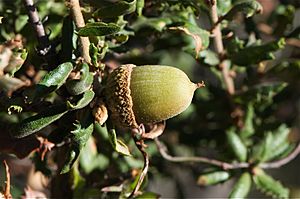Coastal sage scrub oak facts for kids
Quick facts for kids Coastal sage scrub oak |
|
|---|---|
 |
|
| Conservation status | |
| Scientific classification | |
| Genus: |
Quercus
|
| Species: |
dumosa
|
Quercus dumosa is a special kind of plant in the family Fagaceae. It belongs to the white oak group within the oak genus (Quercus). This plant is commonly known as the coastal sage scrub oak or Nuttall's scrub oak. It's usually a shrub that grows in coastal areas.
Where It Lives
The coastal sage scrub oak is found in Baja California (in Mexico) and in California. Sadly, it is an endangered plant. This is because its natural home is being lost due to habitat loss. This oak is so important that it gives its name to a type of plant community. This community is called the "Quercus dumosa chaparral." In these areas, the coastal sage scrub oak and toyon plants often grow together.
What It Looks Like
The Quercus dumosa is an evergreen shrub. This means it stays green all year long. It usually grows about 1 to 3 meters (about 3 to 10 feet) tall. It has a large, deep root system. This helps it find water deep underground. The leaves of this oak have spiny or toothed edges.
The fruit of this oak is an acorn. These acorns can be up to 1.5 centimeters (about 0.6 inches) wide. Some plants produce many acorns, while others produce very few. Acorns fall from the tree and are spread by gravity. Animals like squirrels and jays also pick them up. These animals either eat the acorns right away or hide them for later. The acorns usually sprout easily. However, new plants from seeds usually only grow in very wet years.
Allergies
The Coastal Sage Scrub Oak (Quercus dumosa) can cause severe allergies. Its pollen is released in the spring. The exact time depends on how far north or south the plant is and how high up it grows.
How It Grows
Quercus dumosa mostly grows in sandy soils. You can often find it near the coast, especially in areas called chaparral. This oak is very good at growing back after a wildfire. It can sprout strongly from its stump and roots. Within a few years after a fire, it can grow a large leafy top again. Sometimes, it grows alongside Ceanothus species just four years after a fire. This oak also does well even when there are no fires.
See also

- In Spanish: Quercus dumosa para niños


